II. Contents of the 2MASS Spring 1999 Incremental Data Release
3. Extended Source Catalog (XSC)
a. Extended Source Catalog Format
The first 2MASS public data release consists of ~6% of the northern
sky (low declination bands). The extended source catalog (XSC) contains
73,980 sources, all which have the following properties:
Most of the sources are galaxies (particularly as measured with the
G_score). Approximately ~2-5% of the catalog are non-galaxies for
low confusion areas, consisting of either double stars or artifacts
(e.g., pieces of bright stars). The following plots illustrate
some of the basic properties of the XSC. An image gallery is given at
the end of this page. More information on the algorithms, derived
parameters and the catalog/database, can be found at
2MASS Extended Source Catalog I: Overview and Algorithms.
Figure 1 shows the sky distribution of this first
release XSC. The Galactic Plane is denoted with a red dashed line.
Figure 2 shows the fractional distribution of
2MASS XSC sources with galactic latitude. Note that the source counts are
not normalized by the areal coverage.
Figure 3 shows the differential extended source
counts corresponding to low stellar confusion fields, <1200 stars
deg-2 brighter than mag=14 at Ks. The error bars
represent sqrt(n) uncertainty measures. The sources comprise a total areal
coverage of ~2350 square degrees. Most of the area is free of known nearby
clusters (redshift z < 0.1), but a small percentage does include the
Abell 262 cluster in Perseus and the outer fringes of the Virgo cluster. For
comparison, deep but narrow-field counts from Glazebrook et al. (1994, MNRAS,
266, 65), denoted with a dotted line, and Gardner et al. (1997, ApJ, 480, L99),
denoted with "+" symbols, are shown.
b. XSC Catalog Selection Criteria:
c. General Properties
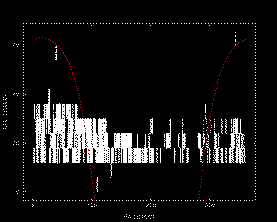
|
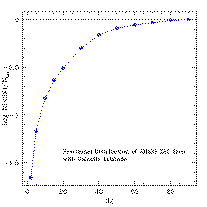
|
 |
| Figure 1 | Figure 2 | Figure 3 |
d. Photometric Properties
Figure 4 is the color-color distribution for extended sources located within low stellar confusion fields, <1200 stars deg-2 brighter than mag=14 at Ks. The galaxy color-color is demarked by symbols coded according to the J-Ks SNR. The solid lines denote the main sequence locus (giants diverge at large J-H). The dashed line and triangle points denote the K-correction curve for a spiral galaxy (no evolution), where each triangle represents 0.1 in redshift (z).
Figure 5 is the color-color distribution for extended sources located within moderate stellar confusion fields, 1200 - 4000 stars deg-2 brighter than mag=14 at Ks.
Figure 6 is the color-color distribution for extended sources located within moderate stellar confusion fields, >4000 stars deg-2 brighter than mag=14 at Ks. Extinction from obscuring dust in the Milky Way is a significant reddening component. Approximately half of the sources are double or triple star clusterings.
Figure 7 shows the expected number of double and triple stars (dotted lines) with galactic latitude. For comparison, the total number of stars (solid line) and the expected number of field galaxies (dashed line) are given. The longitude is fixed at 90°. The calculations are based on the starcount models of Jarrett (1992, PhD Thesis, UMass). Double stars, dominated by sky-projected associations, represent primary-secondary separations < 6´´ (the 2MASS PSF, for comparison, has a FWHM > 2´´). The galaxy counts are based on 2MASS data.
Figure 8 shows the predicted stellar number density, log [stars per deg2] brighter than mag=14 at Ks, as a function of galactic latitude. Two sets of solutions are shown, that of 50° galactic longitude (solid line) and 130° galactic longitude (dashed line). The dashed lines define regions of low (< 3.1), moderate (3.1 to 3.6) and high (> 3.6) stellar number density. The estimated confusion noise (Dmag) as a function of the stellar number density is denoted by the dot-dashed line, assuming index a = 1, outlier cutoff q=5s, and the beam size is 5´´.
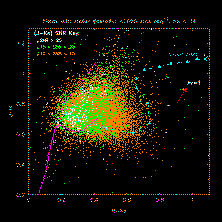
|

|
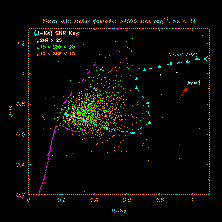 |
| Figure 4 | Figure 5 | Figure 6 |
Figure 9 shows the angular size of extended sources as
a function of Ks. The top panel shows the size distribution
(in arcsec) of the semi-major axis radius corresponding to the best fit
ellipse of the 20 mag arcsec-2 Ks-band isophote. The
minimum radius corresponds to 7´´ (horizontal dashed line). The
middle panel shows the size distribution of the semi-major axis radius
corresponding to the best fit ellipse of the 21 mag arcsec-2 J-band
isophote. The bottom panel shows the semi-major axis radius corresponding to
the 3
e. Size Distribution
 Ks-band isophote,
corresponding to roughly 18.8 mag arcsec-2 surface brightness.
The minimum 3
Ks-band isophote,
corresponding to roughly 18.8 mag arcsec-2 surface brightness.
The minimum 3 radius is ~5´´.
Note: for the 3
radius is ~5´´.
Note: for the 3 distribution, only about
half of the sources are plotted.
distribution, only about
half of the sources are plotted.
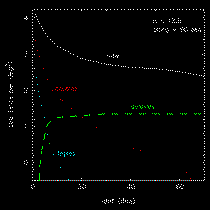
|
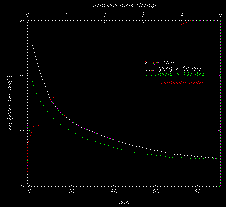
|
 |
| Figure 7 | Figure 8 | Figure 9 |
f. Relevant Images
 Examples of large 2MASS Virgo galaxies as seen in composite JHKs.
Each image is 101´´ in angular size, the maximum size for 2MASS
extended source "postage-stamp" images. Reading left to right: (top panel)
Messier 100, Messier 98, NGC 4340, NGC 4189; (bottom panel) NGC 4305,
NGC 4344, IC 769, NGC 4165.
Examples of large 2MASS Virgo galaxies as seen in composite JHKs.
Each image is 101´´ in angular size, the maximum size for 2MASS
extended source "postage-stamp" images. Reading left to right: (top panel)
Messier 100, Messier 98, NGC 4340, NGC 4189; (bottom panel) NGC 4305,
NGC 4344, IC 769, NGC 4165.
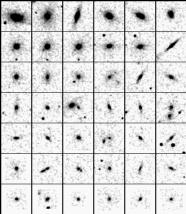 Bright 2MASS galaxies as seen in the Ks-band.
The sequence is arranged in order of integrated Ks-band flux,
reading left to right. 1st panel: Ks mags range from 9 to 10.5; 2nd panel: 10.5 to 11.0; 3rd panel: 11.0 to 11.6; 4th panel: 11.6 to 12.1;
5th panel: 12.1 to 12.3; 6th panel: 12.3 to 12.6; last panel: 12.6 to 12.9.
Each image is 60´´ in angular width.
Bright 2MASS galaxies as seen in the Ks-band.
The sequence is arranged in order of integrated Ks-band flux,
reading left to right. 1st panel: Ks mags range from 9 to 10.5; 2nd panel: 10.5 to 11.0; 3rd panel: 11.0 to 11.6; 4th panel: 11.6 to 12.1;
5th panel: 12.1 to 12.3; 6th panel: 12.3 to 12.6; last panel: 12.6 to 12.9.
Each image is 60´´ in angular width.
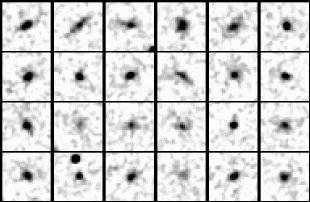 2MASS galaxies at the Ks-band sensitivity requirement limit,
Ks~13.5 mag. The sequence is arranged in order of integrated
Ks-band flux, reading left to right. 1st panel: Ks mags
range from 13 to 13.1; 2nd panel: 13.1 to 13.3; 3rd panel: 13.3 to 13.4;
last panel:13.4 to 13.5. Each image is 30´´ in angular width.
2MASS galaxies at the Ks-band sensitivity requirement limit,
Ks~13.5 mag. The sequence is arranged in order of integrated
Ks-band flux, reading left to right. 1st panel: Ks mags
range from 13 to 13.1; 2nd panel: 13.1 to 13.3; 3rd panel: 13.3 to 13.4;
last panel:13.4 to 13.5. Each image is 30´´ in angular width.

Galaxies found in the Galactic Plane (approx coords: 240°,
+4.5°), corresponding to a density of 4500 stars deg-2
brighter than Ks mag=14. The sequence is arranged in order of
integrated Ks-band flux, ranging 11.8 to 13.8 mag (reading left to
right). The upper row corresponds to the J-band postage stamp image; middle
row, the H-band; and, bottom row, the Ks-band images. Each image is
50´´ in angular width.

Galaxies found near the Galactic Center bulge (approx coords: 12°,
+5.0°), corresponding to a density of 30,000 stars deg-2
brighter than Ks mag=14. The sequence is arranged in order of
integrated Ks-band flux, ranging 11.0 to 12.7 mag (reading left to
right). The upper row corresponds to the J-band postage stamp image; the
middle row, the H-band; and, the bottom row, the Ks-band images.
Each image is 50´´ in angular width.
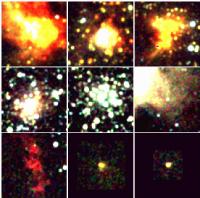 Galactic extended sources. JHKs three-color images of
H II regions (upper panel), clusters and nebulosity (middle panel; far right
image corresponds to a piece of the Crab Nebula), reflection nebulae and young
stellar objects (bottom panel).
Galactic extended sources. JHKs three-color images of
H II regions (upper panel), clusters and nebulosity (middle panel; far right
image corresponds to a piece of the Crab Nebula), reflection nebulae and young
stellar objects (bottom panel).
[Last Updated: 1999 May 6; by T. Jarrett]
Previous page. Next page.
Return to Explanatory Supplement TOC Page.